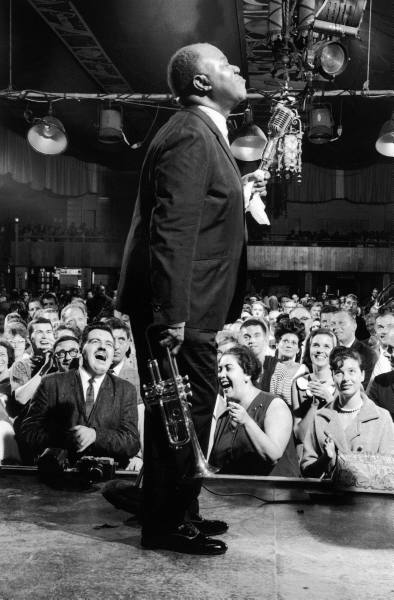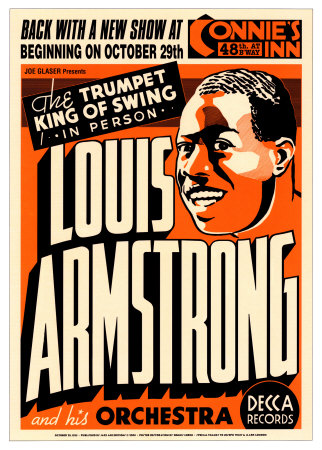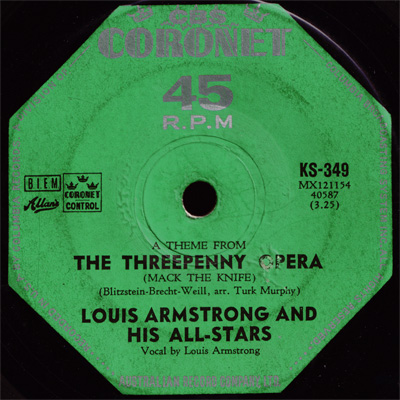 Asked whether he preferred the trumpet playing of Bobby Hackett or Billy Butterfield, Louis Armstrong thought it over and replied, “Bobby. He got more ingredients.” That’s one of my favorite Armstrong lines, and I like to think that it also applies to Pops: A Life of Louis Armstrong, my forthcoming biography of the greatest jazz musician of the twentieth century.
Asked whether he preferred the trumpet playing of Bobby Hackett or Billy Butterfield, Louis Armstrong thought it over and replied, “Bobby. He got more ingredients.” That’s one of my favorite Armstrong lines, and I like to think that it also applies to Pops: A Life of Louis Armstrong, my forthcoming biography of the greatest jazz musician of the twentieth century.
I’m working on the catalogue copy for Pops, which will be published by Harcourt this fall, and so I’m starting to grapple with the ever-vexing problem of self-promotion. Sooner or later, everyone who interviews me about Pops will ask some variation on this question: Why do we need another book about Satchmo? The short answer is that I am the first biographer to have had access to six hundred and fifty reels of tape recordings privately made by Armstrong during the last quarter-century of his life, many of which contain revealing after-hours conversations in which he speaks with breathtaking frankness about his life and work. More generally, I’ve been able to draw on a wide variety of other material that was unavailable or unknown to Laurence Bergreen when he wrote Louis Armstrong: An Extravagant Life, the last primary-source Armstrong biography, which was published twelve years ago.
All well and good–but what did I do with my new ingredients? To put it as simply as possible, I’ve sought to write a narrative biography of Armstrong that is comparable in seriousness and scope to such “definitive” high-culture biographies as W. Jackson Bate’s Samuel Johnson, George Painter’s Marcel Proust, or David Cairns’ Berlioz. Next to no popular-music biographies have aspired to the high standards set by these books, but it seemed self-evident to me that Louis Armstrong was a figure of similar artistic and cultural significance, and so deserved to be written about in the same way.
Such a biography is by definition several books in one:
• Just the facts, ma’am. The first job of a biographer is to tell the story of his subject’s life as accurately as possible. In order to do this, I’ve digested a vast amount of source material, all of it documented in a 27,000-word chapter of source notes.
To give you an idea of how much work this entailed, here’s a paragraph from Pops:
The best-remembered number in the Creole Jazz Band’s repertoire is “Dipper Mouth Blues,” jointly credited to Joe Oliver and Armstrong and recorded twice, for Gennett in April and again for OKeh two months later. (The title came from one of the many nicknames inspired by Armstrong’s large mouth.) Armstrong was the first of scores of jazzmen to learn Oliver’s climactic solo by heart and, later, to record it himself. “Everything I did, I tried to do it like Oliver,” he said. Even in 1923, however, that was no longer true. Oliver used mutes to alter the timbre of his cornet, making it cry like a baby or curse like a man, while Armstrong rarely used anything but a simple straight mute and never indulged in the tonal trickery for which Oliver was renowned. It was not for lack of trying: Lil Armstrong claimed that he spent a whole week trying without success to imitate Oliver’s “wah-wah” muted inflections on “Dipper Mouth Blues.” “Louis never could play that solo like Joe,” she said. “And I think it kind of discouraged him because Joe was his idol and he wanted to play like Joe.” But thereafter he cultivated a shining tone that dwarfed the smaller sound of his mentor, just as his studies had given him a foundation of formal knowledge that Oliver, who readily confessed to being a poor sight reader, could not hope to rival.
And here are the source notes for that paragraph:
Jointly credited to Oliver and LA: Brian Harker has speculated that LA wrote the introduction to “Dipper Mouth Blues,” a sequence of descending diminished-seventh arpeggios (Harker, “Louis Armstrong and the Clarinet,” American Music, Summer 2003). “Everything I did”: Will Jones, “It’s the Bunk, but It Helped,” Minneapolis Tribune, July 20, 1949. LA spent a whole week: William Russell, “Louis Armstrong”; Frederic Ramsey Jr., Jazzmen, 126. “LA never could play that solo”: Lil Armstrong, Satchmo and Me, recorded interview (Riverside). He readily confessed to being a poor sight reader: “I’m the slowest goddamned reader in the band” (Clyde Bernhardt, I Remember: Eighty Years of Black Entertainment, Big Bands, and the Blues, 94). That Oliver could read music, however, is not in doubt. On the 1924 duet recording of “King Porter” that he made with Jelly Roll Morton, he is reading from the written cornet part to the stock orchestration of Morton’s most famous composition (Samuel Charters, A Trumpet around the Corner, 216).
You get the idea.
 • Department of corrections. Every book about Louis Armstrong published before 1999 contains numerous factual errors, some minor and others substantive. In that year Thomas Brothers edited Louis Armstrong, in His Own Words: Selected Writings, the first collection of Armstrong’s hitherto-unpublished autobiographical manuscripts and uncollected articles and correspondence and the first full-length book about Armstrong by an academic scholar.
• Department of corrections. Every book about Louis Armstrong published before 1999 contains numerous factual errors, some minor and others substantive. In that year Thomas Brothers edited Louis Armstrong, in His Own Words: Selected Writings, the first collection of Armstrong’s hitherto-unpublished autobiographical manuscripts and uncollected articles and correspondence and the first full-length book about Armstrong by an academic scholar.
Since then other scholars have started exploring in earnest the archival material on which Pops is based. Thanks to my own research and the invaluable work of these men and women, Pops contains the most accurate accounts published to date of Armstrong’s early musical training; his 1928 recording sessions with Earl Hines; his 1929 Broadway debut; his 1930 marijuana arrest; his 1931 skirmish with the Chicago mob; his relationships with Tommy Rockwell, Johnny Collins, and Joe Glaser, the three white managers who directed his career; his trips to Europe in the early Thirties; his decision to break up his big band in 1947 and start playing with a combo; his 1957 quarrel with President Eisenhower over Orval Faubus’ attempt to block the desegregation of the public schools of Little Rock, Arkansas; the 1963 session at which he recorded “Hello, Dolly!”; and countless other matters large and small.
Like most larger-than-life historical figures, Armstrong generated his share of apocrypha. You will find none of it in Pops, which contains no unsupported assertions or unsourced “quotes.” In particular, every statement by Armstrong that is cited in Pops has been traced back to its earliest known source.
• Critical perspective. Pops is the first fully sourced biography of Louis Armstrong to be written by an author with musical training. While it’s primarily narrative, not critical, I’ve also tried to deepen the reader’s understanding of Armstrong’s music, both by discussing selected recordings by Armstrong in close but (I hope) intelligible detail and by situating them in the context of his life.
Here’s an example, an excerpt from the fourth chapter of Pops in which I talk about “Weather Bird,” one of Armstrong’s most important and influential records:
It became customary for Armstrong and his sidemen (except for Earl Hines, who disliked marijuana) to get high before making a record, which probably explains how “Muggles” got its name. But it is unlikely that Armstrong was anything other than clear-headed when, two days earlier, he and Hines recorded “Weather Bird,” the most forward-looking of the three dozen 78 sides they made together in 1927 and 1928. It was the sole occasion on which they went it alone in the studio, and they took full advantage of their freedom, sailing through a duet that resembles “Skip the Gutter” sped up and writ large. Again one gets the feeling that Hines is trying to give his partner the rhythmic slip, but never quite successfully. The strongest impression left by “Weather Bird,” though, is of an airy lightness made possible by the absence of a rhythm section, combined with a sense of awe at the incisiveness of musical argument. Armstrong called the recording “our vir-tee-o-so number,” and Hines claimed that the trumpeter spun it out of thin air. “We had no music,” he recalled. “It was all improvised, and I just followed him.” Perhaps the pianist was unaware that the song, a multi-themed rag composed by Armstrong, had been recorded by the Creole Jazz Band in 1923, but the first half of the Armstrong-Hines version follows the earlier recording fairly closely, suggesting that their performance, for all its seeming spontaneity, may in fact have been rehearsed with some care. Nor was “Weather Bird” the first recorded jazz duet: Joe Oliver and Jelly Roll Morton had already cut two. It was, however, the first such recording of any musical significance, and its quicksilver brilliance has yet to be surpassed.
 • Cultural context. Because Armstrong’s significance extends beyond the realm of jazz proper, I have sought at various points in Pops to place him in the larger world of art and culture. Here’s another excerpt from the fourth chapter, in which I talk about the relationship between Armstrong and Earl Hines:
• Cultural context. Because Armstrong’s significance extends beyond the realm of jazz proper, I have sought at various points in Pops to place him in the larger world of art and culture. Here’s another excerpt from the fourth chapter, in which I talk about the relationship between Armstrong and Earl Hines:
For both men 1928 was their floruit, a year of triumphs to which all their subsequent undertakings would forever after be compared. The time was ripe for such prodigies, with modernism at its apogee and mass-reproduced popular culture in its first flower. It was the year of Lady Chatterley’s Lover and “Makin’ Whoopee,” Evelyn Waugh’s Decline and Fall and Walt Disney’s “Steamboat Willie,” the Stravinsky-Balanchine Apollo and the Brecht-Weill Dreigroschenoper. Jazz, too, had by 1928 won a measure of acceptance in highbrow circles that in retrospect is striking, even startling, given its recent origins in the honkytonks of New Orleans. George Gershwin, who thought it to be “the only musical idiom in existence that could aptly express America,” made use of jazz-derived musical techniques in An American in Paris, premiered by the New York Philharmonic that December to general acclaim. When Maurice Ravel came to New York earlier in the year to play his jazz-flavored violin sonata with Joseph Szigeti, he assured reporters that American classical composers would do well to take jazz seriously: “I am waiting to see more Americans appear with the honesty and vision to realize the significance of their popular product, and the technic and imagination to base an original and creative art upon it.”
Too often jazz is written about as if it exists in a cultural vacuum. It is, I believe, worth knowing that Philip Larkin praised Louis Armstrong as “an artist of Flaubertian purity…more important than Picasso,” just as it is more than merely interesting to know that Armstrong was listening to and collecting opera recordings as a young man in New Orleans: “I had Caruso…Galli-Curci, Tetrazzini–they were all my favorites. Then there was the Irish tenor, McCormack–beautiful phrasing.”
• Reception history. Surprisingly little has been written about the way in which Armstrong was covered by the journalists of his day. When did his name first appear in Time, The New Yorker, and the New York Times? When was he first written up in Walter Winchell’s column? How did the English press react to his London debut in 1932? At what point did critics start to dismiss his once-revolutionary music as old-fashioned? You’ll find the answers in Pops.
• Trivial pursuits. Because I wrote Pops for a general audience, I deliberately kept the text free of scholarly minutiae. On the other hand, the source notes contain many tidbits that will be of consuming interest to Armstrong specialists. Exactly how tall was he? Was the battered cornet that the Smithsonian Institution acquired in 2002 really the actual instrument on which he learned to play? Where and when did he first meet Jack Teagarden? Was the name of his 1937 radio show Harlem or Harlem Radio Review? Might he possibly have been sterile–and if so, why? It’s all in the notes.
That’s a whole lot of ingredients to cram into one book–but, then, such thoroughness is taken for granted in the field of literary biography. Alas, you can count on the fingers of one hand the previous jazz biographies that seek to accomplish all of the aforementioned goals. One of the few books about a major jazz musician that is directly comparable to Pops is, appropriately enough, Bix: Man and Legend, the 1974 Richard M. Sudhalter-Philip R. Evans biography of Bix Beiderbecke, Armstrong’s friend and peer. I have done my best to make Pops worthy of its great predecessor.
* * *
Here’s part of a little-known video clip that I unearthed and used as a key source for the first chapter of Pops. It’s Armstrong’s 1965 appearance on the TV game show I’ve Got a Secret, during which he was reunited with Peter Davis, his very first music teacher:
